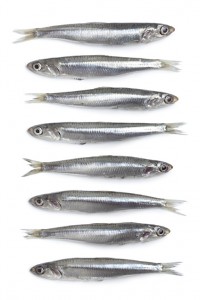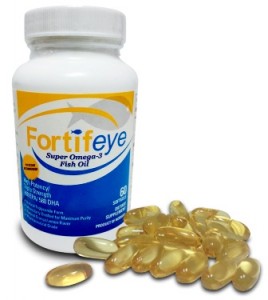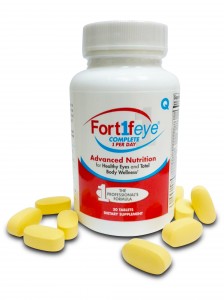Dr. Michael Lange on natural approach for dry eyes and discussion of the metabolic pathways of omega-6 and omega-3 in regards to dry eye and health
There are some great nutritional approaches that may improve the symptoms of dry eye syndrome, however most eye care providers, MDs, DOs and ODs are under utilizing this complimentary nutritional support for dry eyes.
 First and foremost our diets and lifestyles need to be overhauled. In America our diets are caloric dense and nutrient deficient, consisting of way too much omega-6 fatty acids (oils from soy, corn, cottonseed, canola, sunflower and safflower), saturated fats and trans fats, thus increasing the chance of inflammation in our bodies. The typical western diet has too high an intake of omega-6 and too low an intake of omega-3 fatty acids; this is associated with increased levels of cytokines, proteins that trigger inflammation. Inflammation is one of the root causes of dry eye syndrome (keratoconjunctivitis sicca) and many other systemic diseases. Therefore we must decrease our consumption of processed foods, fast foods, canned foods, commercially raised beef, chicken, turkey and farm raised fish and eat more wild fish, free range chicken and turkey, free roaming organic grass fed beef, more fruits and vegetables (organically grown if possible), drink more
First and foremost our diets and lifestyles need to be overhauled. In America our diets are caloric dense and nutrient deficient, consisting of way too much omega-6 fatty acids (oils from soy, corn, cottonseed, canola, sunflower and safflower), saturated fats and trans fats, thus increasing the chance of inflammation in our bodies. The typical western diet has too high an intake of omega-6 and too low an intake of omega-3 fatty acids; this is associated with increased levels of cytokines, proteins that trigger inflammation. Inflammation is one of the root causes of dry eye syndrome (keratoconjunctivitis sicca) and many other systemic diseases. Therefore we must decrease our consumption of processed foods, fast foods, canned foods, commercially raised beef, chicken, turkey and farm raised fish and eat more wild fish, free range chicken and turkey, free roaming organic grass fed beef, more fruits and vegetables (organically grown if possible), drink more  filtered or spring water
filtered or spring water
and get plenty of good sleep and exercise. Sleep deprivation and sedimentary lifestyle are also contributing factors that increase cortisol levels, stress and inflammation in the body. At checkout Apply Coupon Code Multi3 to receive 15% off (3) or more Fortifeye Products.
Take omega-3 fish oil for essential fatty acids
 The simplest way to offset the imbalance between omega-6 and omega-3 in our diets is to eat fewer foods that are high in omega-6 and more foods that are high in omega-3 and increase your intake of omega-3 fatty acids from a good omega three fish oil supplement. The best source of omega three comes from marine sources like sardines, mackerel, wild salmon, anchovies, krill and squid. Alternative vegetable sources of omega three fatty acids are plankton/algae, chia seed oil and flax seed oil. The more bioavailable form of omega three essential fatty acids will come from the marine sources mentioned. The numerous health benefits of omega three fatty acids have been studied thoroughly, with subjects getting omega three fish oil from consuming more fish or taking a fish oil omega three supplement.
The simplest way to offset the imbalance between omega-6 and omega-3 in our diets is to eat fewer foods that are high in omega-6 and more foods that are high in omega-3 and increase your intake of omega-3 fatty acids from a good omega three fish oil supplement. The best source of omega three comes from marine sources like sardines, mackerel, wild salmon, anchovies, krill and squid. Alternative vegetable sources of omega three fatty acids are plankton/algae, chia seed oil and flax seed oil. The more bioavailable form of omega three essential fatty acids will come from the marine sources mentioned. The numerous health benefits of omega three fatty acids have been studied thoroughly, with subjects getting omega three fish oil from consuming more fish or taking a fish oil omega three supplement.
Triglyceride based fish oil vs. ethyl ester fish oil
Omega three fish oil comes in two readily available forms over the counter at the local drug store or health food store. Ethyl ester fish oil and triglyceride fish oil are the two forms that can be purchased OTC (over the counter). The ethyl ester version of fish oil is less expensive and is being recommended less and less by health care providers that are in tune with nutrition. However many physicians are not aware of the difference between the two types of fish oil and thus may be still recommending the cheaper less bioavailable ethyl ester form of omega three. Be careful when purchasing omega three fish oil at the local drugstore or warehouse club because they can be contaminated with unhealthy levels of PCBs and most contain ethanol. Most OTC omega three fish oils are ethyl ester based fish oil. The purification process uses ethanol to distill and concentrate the fish oil and the process to remove the ethanol after distillation is expensive. This additional processing expense to re-convert ethyl ester based fish oil back to the natural triglyceride form is the main reason companies are utilizing the ethyl ester version. Most fish oil that is associated with burping up a nasty fish taste is the ethyl ester version. The ethyl ester version has decreased absorption over triglyceride based fish oil and potential free radical damage exists with ethanol. Any amounts of ethanol are contraindicated in  pregnant and nursing mothers, infants , toddlers or anyone with liver problems. So best to be safe and just dont recommend ethyl ester based fish oils to anyone. Ethanol is an additive used in gasoline and is a fuel used in high performance race cars. It’s not something to put in your stomach. Fish oil should be consumed in the form that is found naturally in the sea, the natural triglyceride form. If you are not sure about the product you are taking, you can call the customer service number on the back of your fish oil supplement bottle and ask what form the fish oil is in. Small dosages of ethyl ester fish oil taken with food are probably relatively safe, but with more and more patients taking higher dosages of this form who knows what potential complications we could see in the future? Spend a little extra when purchasing an omega three fish oil and obtain the triglyceride form!
pregnant and nursing mothers, infants , toddlers or anyone with liver problems. So best to be safe and just dont recommend ethyl ester based fish oils to anyone. Ethanol is an additive used in gasoline and is a fuel used in high performance race cars. It’s not something to put in your stomach. Fish oil should be consumed in the form that is found naturally in the sea, the natural triglyceride form. If you are not sure about the product you are taking, you can call the customer service number on the back of your fish oil supplement bottle and ask what form the fish oil is in. Small dosages of ethyl ester fish oil taken with food are probably relatively safe, but with more and more patients taking higher dosages of this form who knows what potential complications we could see in the future? Spend a little extra when purchasing an omega three fish oil and obtain the triglyceride form!
The Styrofoam test for ethyl ester based fish oil
 A simple test you can perform at home is to squeeze your fish oil into a Styrofoam cup and see what happens after fifteen minutes. If the cup starts to melt, then it is the ethyl ester based fish oil. You may want to think twice about consuming it or giving it to your children or grandparents.
A simple test you can perform at home is to squeeze your fish oil into a Styrofoam cup and see what happens after fifteen minutes. If the cup starts to melt, then it is the ethyl ester based fish oil. You may want to think twice about consuming it or giving it to your children or grandparents.
Triglyceride based fish oil – Fortifeye Super Omega
Learn about Fortifeye Super Omega triglyceride based fish oil at old.fortifeye.com. If you have access to wild Alaskan salmon,  eat it at least three times per week or more, or consume more of the small fish like sardines or anchovies. Be careful and try not to eat any large predatory type fish due to the potential contaminants in their flesh like PCBs, organophosphates, mercury and lead. Avoid eating farm raised salmon since it has a higher ratio of omega 6 fatty acids than wild salmon. Farm raised salmon are fed grains and fish meals made from contaminated predatory fish which increases levels of contaminants in the farm raised salmon. Most farm raised salmon are fed a synthetic dye to get its orange color. Eating more wild cold water fish or taking a good triglyceride based fish oil supplement will increase the omega-3 content in your body and help with your overall health as well as improve dry eyes. Take a good triglyceride based fish oil, not ethyl ester fish oil. The triglyceride based fish oil Fortifeye Super Omega has 900 EPA and 600 DHA in two gel caps or the Fortifeye Super Omega 3 Max that has 1200 EPA and 900 DHA in 2 gel caps.
eat it at least three times per week or more, or consume more of the small fish like sardines or anchovies. Be careful and try not to eat any large predatory type fish due to the potential contaminants in their flesh like PCBs, organophosphates, mercury and lead. Avoid eating farm raised salmon since it has a higher ratio of omega 6 fatty acids than wild salmon. Farm raised salmon are fed grains and fish meals made from contaminated predatory fish which increases levels of contaminants in the farm raised salmon. Most farm raised salmon are fed a synthetic dye to get its orange color. Eating more wild cold water fish or taking a good triglyceride based fish oil supplement will increase the omega-3 content in your body and help with your overall health as well as improve dry eyes. Take a good triglyceride based fish oil, not ethyl ester fish oil. The triglyceride based fish oil Fortifeye Super Omega has 900 EPA and 600 DHA in two gel caps or the Fortifeye Super Omega 3 Max that has 1200 EPA and 900 DHA in 2 gel caps. .
.
A good omega three fish oil is anti-inflammatory
There are many dry eye formulas on the market that have relatively low amounts of omega three fish oil combined with all kinds of natural anti-inflammatory nutrients, like curcumin, boswellia, ginger, while willow bark, nettles etc.-one must be careful with these! These nutrients are good for acute inflammatory conditions but not for long term use. Many of these act by inhibiting the COX-2 and LOX( enzyme of leukotriene biosynthesis) pathways. These nutrients that act as a COX-2 inhibitor and block the cyclooxygenase enzymes which are responsible for the bad pro-inflammatory prostaglandin PGE2 and the good anti-inflammatory benefits of series three prostaglandin PGE3! A prostaglandin is any member of a group of lipid compounds that are derived enzymatically from fatty acids and have important functions in the body. These natural COX-2 inhibitors block the good and the bad. PGE2 creates inflammation, however sometimes we need the PGE2 in response to injury to stimulate the healing process so we don’t want to block these long term, and we certainly don’t ever want to block the  benefits of omega three fish oil, the anti-inflammatory series 3 prostaglandins PGE3. Adequate production of series 3 prostaglandins may protect against heart attack, stroke, arthritis, lupus and asthma, and new research may be proving it is beneficial for dry eye syndrome and macular degeneration. Keep in mind that the COX-2 inhibitors like Viox and Celebrex have gained a lot of negative media attention due to potential unwanted health complications. A much better way to help dry eyes and total body health is to maximize the body’s anti-inflammatory ability by giving it the nutrients necessary to do this. We do not want to potentially hinder the positive omega-3 fish oil benefits by using these natural COX-2 inhibitors long term. Omega three fatty acids from fish oil supplements are the best way to stimulate this PGE3 and help reduce inflammation in the body and eyes. For instance, arachidonic acid is a polyunsaturated omega-6 fatty acid which controls a wide variety of bodily functions, especially those functions involving inflammation and the central nervous system. The EPA in fish oil actually has the ability to block the delta 5 desaturase enzyme (D5D) that is responsible for the inflammatory cascade of arachidonic acid in the omega 6 metabolic pathway.
benefits of omega three fish oil, the anti-inflammatory series 3 prostaglandins PGE3. Adequate production of series 3 prostaglandins may protect against heart attack, stroke, arthritis, lupus and asthma, and new research may be proving it is beneficial for dry eye syndrome and macular degeneration. Keep in mind that the COX-2 inhibitors like Viox and Celebrex have gained a lot of negative media attention due to potential unwanted health complications. A much better way to help dry eyes and total body health is to maximize the body’s anti-inflammatory ability by giving it the nutrients necessary to do this. We do not want to potentially hinder the positive omega-3 fish oil benefits by using these natural COX-2 inhibitors long term. Omega three fatty acids from fish oil supplements are the best way to stimulate this PGE3 and help reduce inflammation in the body and eyes. For instance, arachidonic acid is a polyunsaturated omega-6 fatty acid which controls a wide variety of bodily functions, especially those functions involving inflammation and the central nervous system. The EPA in fish oil actually has the ability to block the delta 5 desaturase enzyme (D5D) that is responsible for the inflammatory cascade of arachidonic acid in the omega 6 metabolic pathway.
Benefits of triglyceride based omega three fish oil
 There are many positive health benefits of a good source of EPA and DHA via omega 3 triglyceride based fish oil. You can start to become proactive in the health of your eyes and body by getting the benefits of fish oil from a good quality triple molecular distilled triglyceride based omega three fish oil. Many patients with dry eyes will notice improvements in their dry eye symptomatology simply by adding the correct triglyceride based omega three fish oil to their diet.
There are many positive health benefits of a good source of EPA and DHA via omega 3 triglyceride based fish oil. You can start to become proactive in the health of your eyes and body by getting the benefits of fish oil from a good quality triple molecular distilled triglyceride based omega three fish oil. Many patients with dry eyes will notice improvements in their dry eye symptomatology simply by adding the correct triglyceride based omega three fish oil to their diet.
Metabolic pathways of essential fatty acids
Another way to improve the metabolic pathways of essential fatty acids is to make sure the delta-6 desaturase enzyme (D6D) is working correctly. Alpha-linolenic acid is an organic compound found in canola, soybeans, walnuts, chia and flaxseed oil. D6D is crucial in the omega-3 conversion of alpha-linolenic acid (ALA) to stearidonic acid and ultimately EPA and DHA. D6D is also crucial in the omega-6 conversion of linoleic acid (LA) to gamma-linolenic acid (GLA) which ultimately turns into good anti-inflammatory series one prostaglandin PGE1. A few specific vitamin and mineral cofactors that are extremely necessary for these conversions utilizing D6D are B3, B6, C, zinc and magnesium. Trans fats, saturated fats, alcohol intake, sugar, diabetes, poor pituitary function, low thyroid function, cancer, Sjögren’s syndrome, scleroderma, ulcerative colitis, Crohn’s, liver cirrhosis, elevated cholesterol and immune dysfunction also can inhibit this conversion. As you can see there are many roadblocks that may interfere in the delta 6 desaturase enzyme system in both omega-6 and omega-3 metabolic pathways. This is why ALA (flax seed oil) is oftentimes a poor source of omega three EPA and DHA and why linoleic acid (an unsaturated omega-6 fatty acid found in corn, safflower and sunflower oil) converts oftentimes to the more inflammatory prostaglandins PGE2 instead of PGE1. Consuming more omega-3 from fish oil supplements (or a good fish source versus plant source) will bypass the entire D6D and D5D pathways in the omega-3 metabolism and allow for much more efficient and quicker utilization of EPA and DHA to the anti-inflammatory PGE3 and  LTB5 (anti-inflammatory leukotriene, a lipid that suppresses inflammatory tissue reactions in the body) thus reaping the total health and ocular benefits.
LTB5 (anti-inflammatory leukotriene, a lipid that suppresses inflammatory tissue reactions in the body) thus reaping the total health and ocular benefits.
Under optimal conditions adults can make both DHA and EPA from ALA but these optimal conditions are quite rare in today’s society. Conversion of omega-3 from plants into long chain omega-3 fatty acids found in marine sources is very low. Very minimal amounts of EPA and virtually no DHA are formed from supplemental alpha linolenic acid. So consume more omega-3 via fish oil versus vegetable source ALA. In order to bypass the D6D in the omega-6 pathway and make it more efficient GLA is needed. GLA is found in borage oil, black currant seed oil, evening primrose oil and blue green algae. GLA will then convert to DGLA which ultimately converts to anti-inflammatory PGE1 or pro-inflammatory PGE2.
Healthy diet plus a good omega three fish oil
Following a lifestyle including a proper diet (like the hunter gatherer or Mediterranean diets, from the era before humans suffered from diseases of civilization), consuming more omega-3 (from fish or products like Fortifeye Super Omega), reducing your omega-6 intake and taking a good multi-vitamin (like Fortifeye Complete ) may increase the conversion of DGLA to PGE1 and decrease the conversion down the arachidonic pathway to PGE2 and LTB4 (pro-inflammatory leukotrienes). PGE1 is a good prostaglandin, has potent anti-inflammatory benefits and may help with overall health and better tear secretion. The combination of a good omega three fish oil like Fortifeye Super Omega and Fortifeye Black Currant/GLA may improve overall health and dry eye syndrome. You will have to combine this with the proper diet and hydration. Remember, more is not better-too much GLA may actually increase arachidonic acid and inflammation from PGE2-so always take GLA with triglyceride based fish oil, and not without it.
taking a good multi-vitamin (like Fortifeye Complete ) may increase the conversion of DGLA to PGE1 and decrease the conversion down the arachidonic pathway to PGE2 and LTB4 (pro-inflammatory leukotrienes). PGE1 is a good prostaglandin, has potent anti-inflammatory benefits and may help with overall health and better tear secretion. The combination of a good omega three fish oil like Fortifeye Super Omega and Fortifeye Black Currant/GLA may improve overall health and dry eye syndrome. You will have to combine this with the proper diet and hydration. Remember, more is not better-too much GLA may actually increase arachidonic acid and inflammation from PGE2-so always take GLA with triglyceride based fish oil, and not without it.
Lastly one must eat foods with a low GI (glycemic index) and decrease high GI foods such as potatoes, white pasta, white bread and white rice. This will stop the pancreas from secreting fluctuating amounts of insulin. Elevated insulin, due to lots of refined carbohydrates, will stimulate more conversion of GLA into the pro-inflammatory pathway of arachidonic acid and thus more of the bad prostaglandins PGE2 and LTB4.
Reduce inflammation and improve dry eye symptoms
So in review, eat a ‘hunter gatherer type of diet’ or the ” Lange Survival Diet” . This means lots of fresh vegetables and fruits, nuts and seeds, wild fish, grass fed organically raised beef, organically raised poultry and whole grains. Eliminate or reduce processed foods, refined foods, fast foods, sodas, sugar and salt. Drink plenty of filtered water( half your body weight in ounces) and green tea.  At checkout Apply Coupon Code Multi3 to receive 15% off (3) or more Fortifeye Products.Take a good multivitamin like Fortifeye Complete Plus, take two to four Fortifeye Super Omega pills daily (or an equivalent omega three fish oil) at different times of the day with food, take a Fortifeye Black Currant /GLA (140mg) supplement at the same time you take one of the fish oil supplements, and get some exercise and a good night of sleep. Sleep deprivation increases cortisol levels and inflammatory markers in the blood. Obviously, see your local eye care provider as well.
At checkout Apply Coupon Code Multi3 to receive 15% off (3) or more Fortifeye Products.Take a good multivitamin like Fortifeye Complete Plus, take two to four Fortifeye Super Omega pills daily (or an equivalent omega three fish oil) at different times of the day with food, take a Fortifeye Black Currant /GLA (140mg) supplement at the same time you take one of the fish oil supplements, and get some exercise and a good night of sleep. Sleep deprivation increases cortisol levels and inflammatory markers in the blood. Obviously, see your local eye care provider as well.
If you will do the things discussed in this article you may be helping to reduce inflammation in your body, improve your quality of life and have less dry eye related problems.
Dr. Michael P. Lange
Board Certified Optometric Physician
Certified Nutrition Specialist
Syndicated Daily Talk Show Host (Ask the Doctor)
www.langeeyecare.com
old.fortifeye.com
May 2, 2010, updated 1/4/2019
Author: Dr. Michael P. Lange is a Board Certified Optometric Physician and a Certified Nutrition Specialist who started Lange Eye Care and Associates in Ocala Florida in March 1993. Lange Eye Care opened 13 locations throughout the state of Florida with three surgery centers. The Lange Eye Institute at The Villages in central Florida is home base for many of the nutritional studies that Fortifeye is involved in. Dr. Lange is one of the first doctors in the industry to utilize intracellular blood tests and blood absorption studies to improve the Fortifeye vitamin line. Dr. Lange travels the world for nutritional research gathering valuable information to continuously improve Fortifeye vitamin formulations. Dr. Lange is still involved in the clinical practice of eyecare. He is a guest lecturer, contributing author to many eyecare magazines, and a daily syndicated talk show host of ‘Ask The Doctor’ which broadcasts daily from Tampa Bay on radio stations throughout the country and video streaming all over the world via the Internet.



